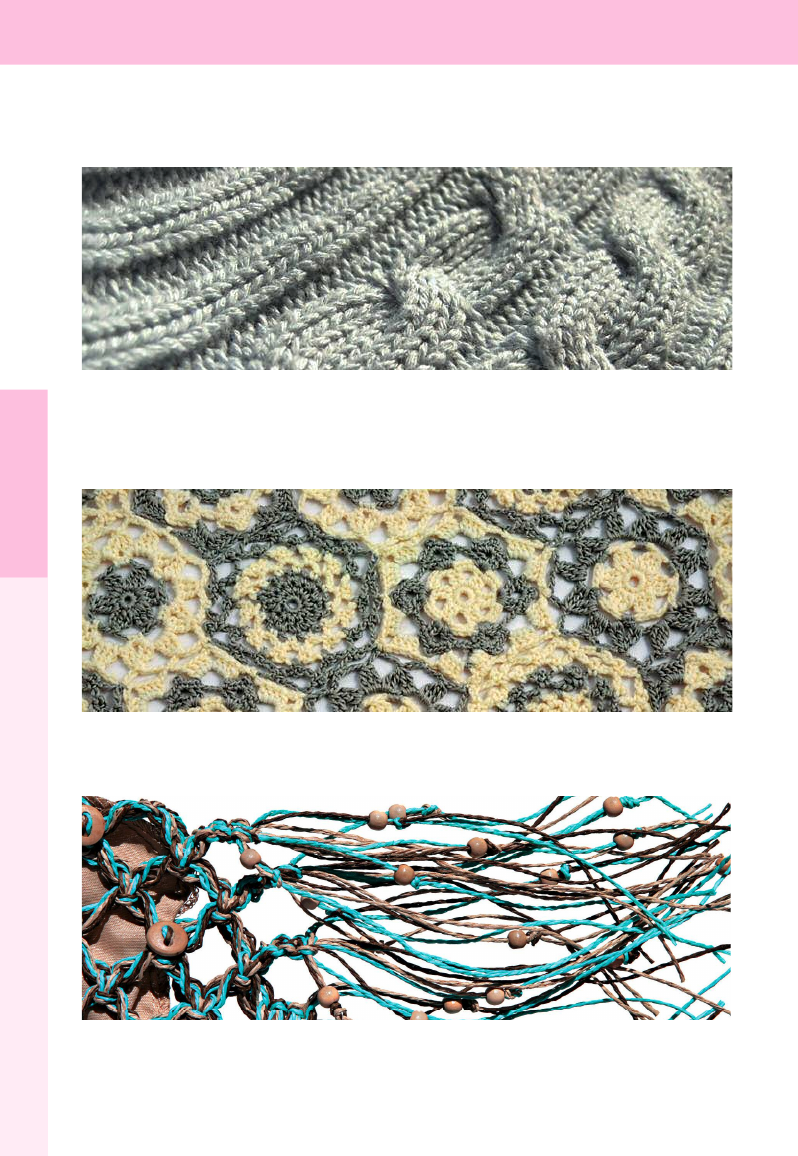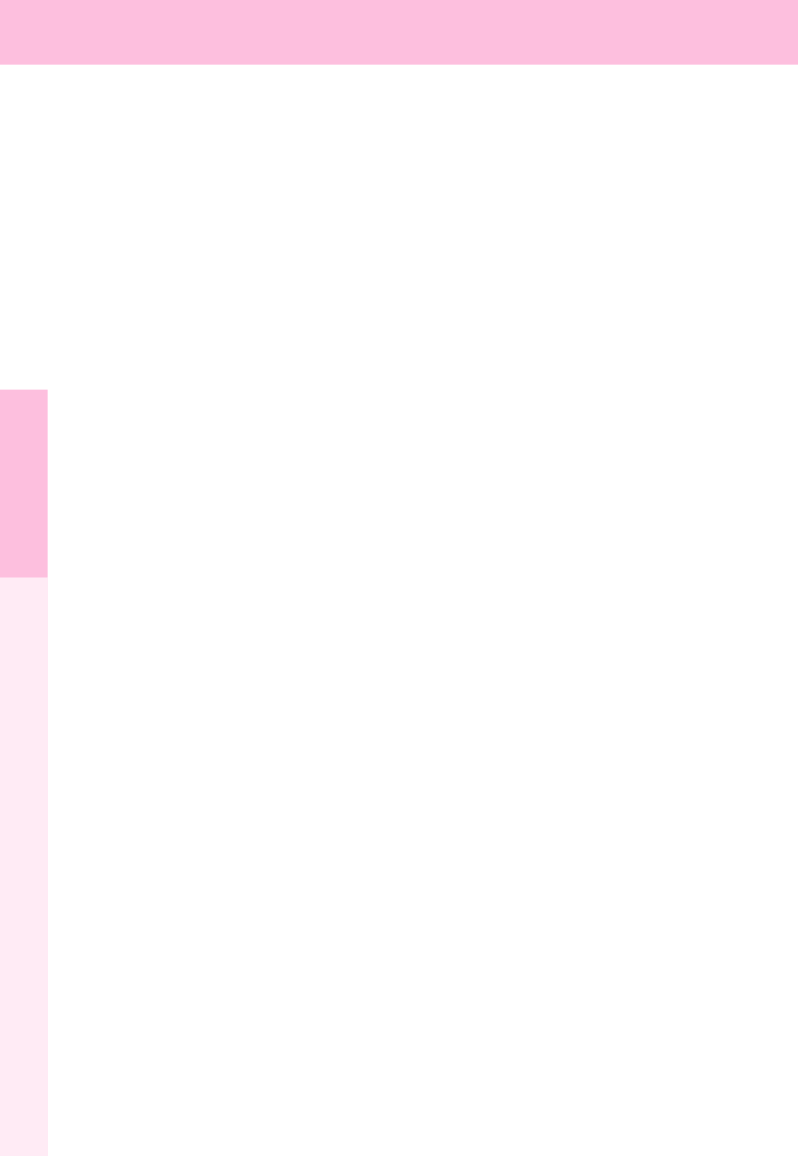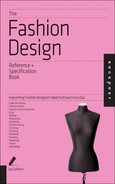
Job:02-30034 Title:RP-Fashion Design Ref and Spec Book
#175 Dtp:225 Page:121
Book
e:120
116-129_30034.indd 121 2/27/13 4:41 PM
Textiles 121
(Text)
Photograph by Danish Khan/iStockphoto.
s,
Twill Weave
Weft threads passes over one (or more) warp
threads, then passes under two (or more) warp
threads. Each consecutive run shifts over slightly;
this offset creates parallel diagonal wales on the
finished fabric. Common fabrics are gabardine,
tweed, serge, and denim.
Plain Weave
Simple criss cross pattern made of the same size
warp and weft threads crossing over each other in
an alternating pattern. Also called tabby weave.
Common fabrics are cotton, percale, voile, chif-
fon, organza, and taffeta.
Basket Weave
A variation of the plain weave, it is typically woven
with two colors of yarn crossing in an alternating
pattern that resembles a basket or checkerboard.
Common fabrics are oxford and monk’s cloth.
Satin Weave
Four or more weft yarns float over a warp yarn
(warp yarns can also float over weft) to create a
lustrous appearance. Common fabrics are satin
and sateen.
Jacquard Weave
A special loom controls the lifting of warp threads,
which allows for fine pattern detail and a more
complex design. Common fabrics are brocade
and damask. For brocades, an additional layer of
decorative weft threads are introduced to produce
a raised, embroidered surface.
Loop and Cut Pile Weaves
Warp threads are raised, producing loops that are
left in tact for a loop pile. Common fabric is terry
cloth. Loops created in the loop pile weave are
sheared to create a cut pile. Common fabrics are
velvet and corduroy.
11
Job:02-30034 Title:RP-Fashion Design Ref and Spec Book
#175 Dtp:225 Page:121
Book
e:120
116-129_30034.indd 121 2/27/13 4:40 PM

Job:02-30034 Title:RP-Fashion Design Ref and Spec Book
#175 Dtp:225 Page:122
116-129_30034.indd 122 2/27/13 4:41 PM
12 2 THE FASHION DESIGN REFERENCE + SPECIFICATION BOOK
(Text)
Crochet: Fabric is created by pulling yarn loops through each other using a crochet hook. It dif-
fers from knitting because only one loop is in play at a time.
Photograph by Jennifer Borton/iStockphoto.
KNITTED, CROCHETED, AND KNOTTED FABRICS
Photograph by Kathryn8/iStockphoto.Photograph by Tamara Kulikova/Fotolia.
Macramé: Textiles are formed by hand using square knots and hitching knots.
L
N
o
R
C
w
H
B
b
d
B
Ta
m
co
K
a
C
o
K
of
p
M
cr
B
Photograph by Dominique Vernier/Fotolia.
Knits: Fabric is made with needles that facilitate the pulling of yarn loops through each other.
The face of the knit structure is represented by knit stitches and the reverse by purl stitches.
Alternating between these stitches allows the knitter to create ribs, cables, and numerous
patterns.
11
Job:02-30034 Title:RP-Fashion Design Ref and Spec Book
#175 Dtp:225 Page:122
116-129_30034.indd 122 2/27/13 4:40 PM

Job:02-30034 Title:RP-Fashion Design Ref and Spec Book
#175 Dtp:225 Page:123
Book
e:122
116-129_30034.indd 123 2/27/13 4:41 PM
Textiles 12 3
(Text)
f-
Photograph by Jennifer Borton/iStockphoto.Photograph by Kathryn8/iStockphoto.Photograph by Tamara Kulikova/Fotolia.
LACES
Needle Lace: Constructed by using needle and thread to create hundreds of tiny buttonhole
or blanket stitches; it is sometimes built on a foundation of paper for control. Styles include
Rose Point, Brussels Point, Point d’Alençon, and Point de Gaze.
Cutwork or Whitework: Constructed by removing threads or cutting areas from a woven fabric,
which is then nished with embroidery and needle lace. Styles include Broderie Anglaise,
Hardanger embroidery, Mountmellick embroidery, and Reticella.
Bobbin Lace: Constructed by braiding and twisting threads attached to wood, bone, or plastic
bobbins; the pattern is controlled with pins stuck into a pillow form. In Milanese lace, the
design is formed of continuous tape or braid. Other styles include Valenciennes, Chantilly,
Brussels, and Genoese.
Tape or Ribbon Lace: Constructed by working textile strips or ribbon into a design by hand or
machine; it can be joined with needle or bobbin lace. Styles include Battenberg Point, Brans-
combe Point, Princess, and Renaissance.
Knotted Lace: Constructed by using a tatting needle or a shuttle to form a pattern of chains
and rings from knots and loops. Also macramé style.
Crocheted Lace: Constructed by crocheting motifs separately then assembling them into lace
or by employing only chain and double/treble crochet stitches to create a gridlike fabric. The
rst style is Irish crochet and the second let crochet.
Knitted Lace: Constructed by knitting with pattern stitches on both the right and wrong sides
of the fabric. Shetland knitted lace, famously, can produce a shawl so ne that it can be
pulled through a wedding ring.
Machine-Made Lace: Almost any style of lace produced by a machine, including imitations of
crochet and macrame, and by-the-yard trims.
Crochet Lace
Photograph by Olga Shelego/Fotolia.
Bobbin Lace
Photograph by Dominique Vernier/Fotolia.
11
Job:02-30034 Title:RP-Fashion Design Ref and Spec Book
#175 Dtp:225 Page:123
Book
e:122
116-129_30034.indd 123 2/27/13 4:40 PM

Job:02-30034 Title:RP-Fashion Design Ref and Spec Book
#175 Dtp:225 Page:124
116-129_30034.indd 124 2/27/13 4:41 PM
124 THE FASHION DESIGN REFERENCE + SPECIFICATION BOOK
(Text)
PERFORMANCE FABRICS
Technological advances have been instrumental in the development of fabrics categorized as
high performance. These fabrics are usually synthetic and are designed to excel in retaining
body heat (Polartec, Primaloft, Thermolite, Thinsulate), ventilation/moisture wicking (Coolmax),
and resisting bacteria, fungi, and yeast (Biofresh). Fabrics have also been designed to be wa-
terproof (Goretex) and windproof (Supplex, Ventile) and to block ultraviolet rays (SolarWeave),
to repel insects (Buzz Off), and to resist abrasions, punctures, and even bullets (ballistic
nylon, Cordura). These fabrics are found predominantly in outerwear and active sportswear,
but are making their way into many other apparel categories. Micro ber is tightly woven from
polyester or nylon laments half the diameter of a strand of silk. The fabric is so ne and soft
to the touch that it is used for evening gowns. The owners of such gowns enjoy the added
bene t of wearing a fabric that protects against water and wind.
FABRIC FINISHING
Greige, or gray, goods are un nished fabrics just removed from a loom or knitting machine.
They are usually rough to the touch and require cleaning before they are t for consumption.
These fabrics undergo several processes in the nal stages of production to re ne them for
the marketplace.
Burling: Removes foreign matter, loose threads, knots, and slubs
Scouring: Removes dirt, oils, sizing, and lint
Mercerization (for cotton): Increases luster, improves strength and af nity for dyes
Bleaching: Prepares fabrics for dyeing
Glazing: Enhances appearance
Sizing: Affects surface touch
Preshrinking: Enhances performance
DYEING
Different fabrics require distinct types of dyes, depending on their ber content. Natural and
man-made fabrics include both cellulose (cotton, linen, hemp, ramie, bamboo and rayon) and
protein (wool, angora, mohair, cashmere, silk, and soy) forms. Cellulose-based fabrics are suc-
cessfully colored using ber-reactive, direct/substantive, and vat dyes (colorless, soluble dyes
xed by light or oxygen). Protein fabrics are best colored by vat, acid, or indirect/mordant dyes
that require a bonding agent. Synthetics do not fall into one category; each require its own
method: polyester (disperse dyes), nylon (acid, disperse, and pigment dyes), spandex (metal
complex acid dyes), rayon acetate (disperse dyes), and acrylic (disperse and basic dyes).
T
p
c
a
k
D
b
w
ag
a
T
A
C
C
L
M
O
P
C
G
H
I
K
L
M
M
P
W
R
R
b
in
re
11
Job:02-30034 Title:RP-Fashion Design Ref and Spec Book
#175 Dtp:225 Page:124
116-129_30034.indd 124 2/27/13 4:40 PM

Job:02-30034 Title:RP-Fashion Design Ref and Spec Book
#175 Dtp:225 Page:125
Book
e:124
116-129_30034.indd 125 2/27/13 4:41 PM
Textiles 12 5
(Text)
),
t
c-
s
s
The history of dyes begins with the development of natural pigments derived from animals,
plants, and minerals. The rst synthetic dye was discovered in 1856. It was aniline purple, also
called mauveine or Perkin’s mauve (after the scientist who discovered it, William Henry Per-
kin). Most dyes currently used are in fact synthetic, but the market for natural dyes is growing.
Dyeing can occur at different stages in the development of the fabric. Fibers can be dyed
before the yarns or threads are spun. Yarn-dyed goods allow for creative versatility during
weaving or knitting by combining different yarn colors in weave patterns. Dyeing fabric yard-
ages is a practical choice when they are meant to be solid colors. In some cases, garments
are produced with undyed fabric, allowing color to be the last stage in the process.
TYPES OF DYE
Animal
Mineral
Cochineal insect (red)
Arsenic (green)
Cow urine (Indian yellow)
Brown clay (umber)
Lac insect (red, violet)
Cadmium (green, red, yellow, orange)
Murex snail (purple)
Carbon (black)
Octopus/Cuttlefish (sepia)
Chromium (yellow, green)
Plant
Cinnabar (vermillion)
Catechu or cutch tree (brown)
Cobalt (blue)
Gamboge tree resin (dark mustard yellow)
Copper (green, blue, purple)
Himalayan rubhada root (yellow)
Hydrated iron oxide (ochre)
Indigofera plant (blue)
Iron oxide (orange-red)
Kamala tree (orange-yellow, golden yellow)
Lead (white, yellow-red)
Larkspur plant (yellow)
Limonite clay (sienna)
Madder root (red, pink, orange)
Titanium (white, beige, yellow, black)
Myrabolan fruit (yellow, green, black)
Zinc (white)
Pomegranate peel (yellow)
Weld herb (yellow)
Resist and Discharge
Resist is when a pattern of wax or other dye-resistant substance is applied to the fabric
before the dyeing process. The uncolored areas create a design. Inversely, discharge print-
ing takes place after the fabric has been dyed. A bleaching chemical applied to the fabric
removes all or some of the color to create a design.
11
Job:02-30034 Title:RP-Fashion Design Ref and Spec Book
#175 Dtp:225 Page:125
Book
e:124
116-129_30034.indd 125 2/27/13 4:40 PM
..................Content has been hidden....................
You can't read the all page of ebook, please click here login for view all page.
